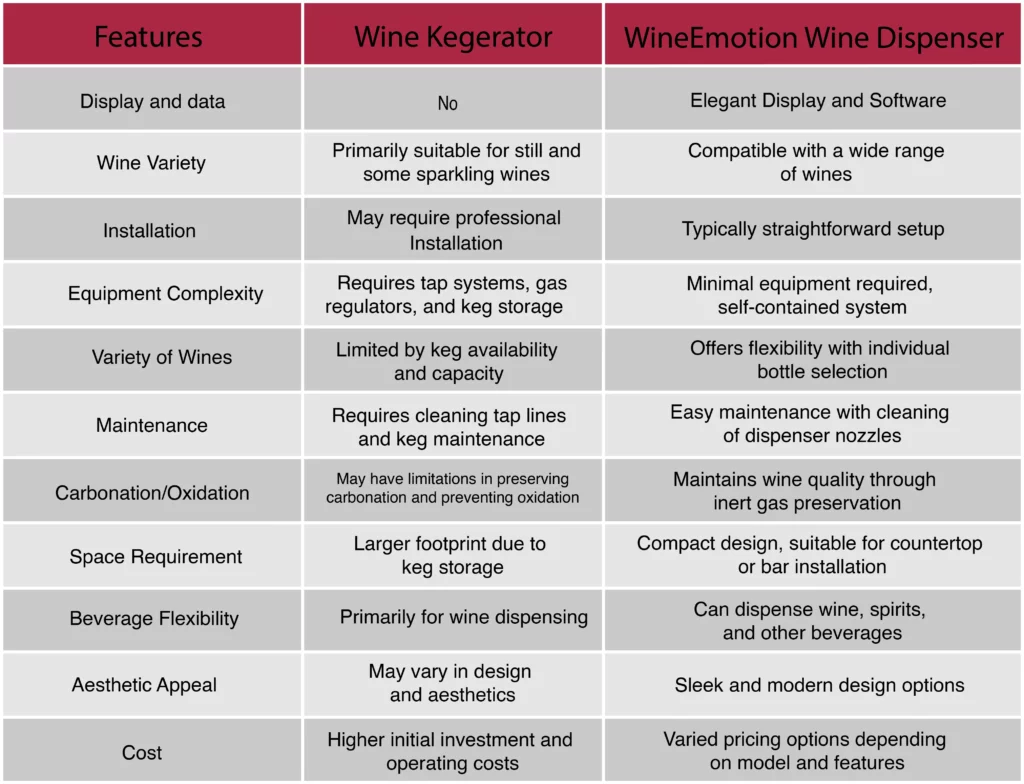Let's start with the basics. A Wine Kegerator stands as a specialized refrigeration system tailored to store and dispense wine from a keg, much like its beer counterpart. These units typically feature a tap system enabling you to pour wine directly from the keg, thereby preserving its freshness and preventing oxidation.

Understanding how a wine kegerator operates can help you appreciate its functionality and benefits. Here's a brief overview of how these systems work:
1. Refrigeration: Like traditional refrigerators, wine kegerators contain a cooling system that regulates the temperature inside the unit. This system keeps the wine stored in the kegs at the optimal serving temperature, typically between 45 to 55 degrees Fahrenheit (7 to 13 degrees Celsius) for most wines.
2. Keg Storage: Wine kegerators feature compartments or racks designed to hold wine kegs securely. These kegs are pressurized containers filled with wine, similar to those used for beer. The kegs are connected to a tap system that allows for easy dispensing of wine.
3. Tap System: The tap system is a crucial component of a wine kegerator. It consists of a faucet or spigot connected to the wine keg via tubing. When the faucet is opened, wine flows from the keg through the tubing and out of the tap, ready to be poured into a glass.
4. Gas System: To maintain freshness and prevent oxidation, wine kegerators often utilize a gas system, typically nitrogen or argon. This inert gas is injected into the keg, creating pressure that pushes the wine out of the keg and into the tap system. The gas also forms a protective barrier on top of the wine, preventing oxygen from coming into contact with it and causing spoilage.
5. Temperature Control: Many wine kegerators come equipped with temperature control features that allow users to adjust the cooling settings according to their preferences. This ensures that the wine remains at the desired temperature for serving, whether it's a crisp white wine or a full-bodied red.
In summary, a wine kegerator works by storing wine kegs in a refrigerated unit, connecting them to a tap system for dispensing, and utilizing a gas system to maintain freshness and prevent oxidation. Temperature control features ensure that the wine is served at the ideal temperature, providing a delightful drinking experience with every pour.
Wine Kegerators are used by a diverse range of individuals and establishments.
The Most Common Users Are:
Wine kegerators cater to a broad spectrum of users, from hospitality professionals to wine enthusiasts seeking convenience, variety, and quality in their wine-serving experience.
Wine Kegerators have gained popularity for several reasons. First and foremost, they offer convenience. By storing wine in a keg, you eliminate the need for individual bottles, which can be cumbersome to store and dispose of. Additionally, kegerators provide a consistent temperature environment, ensuring that your wine is always served at the optimal temperature for enjoyment.
One of the significant advantages of utilizing a Wine Kegerator is its ability to preserve the quality of wine. By storing wine in a keg under controlled conditions, such as consistent temperature and minimal exposure to oxygen, the risk of spoilage and oxidation is greatly reduced. This preservation method ensures that each pour maintains the intended flavors, aromas, and characteristics of the wine, providing a consistently enjoyable drinking experience.
Wine Kegerators offer unparalleled convenience and ease of use. With a simple tap system, you can effortlessly pour a glass of wine at any time without the hassle of uncorking a bottle or worrying about spoilage. This convenience is particularly advantageous for entertaining guests or serving wine in a busy restaurant or bar setting. Moreover, Wine Kegerators often come equipped with features like temperature controls and digital displays, making it easy to monitor and adjust settings as needed for optimal wine storage and dispensing.
Another appealing aspect of Wine Kegerators is their cost efficiency over time. While the initial investment may be higher compared to traditional bottle storage methods, such as wine racks or refrigerators, the long-term savings can be substantial. With a keg system, you eliminate the need for individual bottles, corks, and labels, reducing packaging costs and waste. Additionally, kegs often hold larger volumes of wine than standard bottles, offering better value for money, especially for frequent wine consumers or commercial establishments.
When selecting a Wine Kegerator, it's essential to consider its capacity and size to ensure it meets your specific needs. Assess how much wine you typically consume or plan to serve regularly to determine the appropriate keg size. Additionally, consider the available space in your home or establishment where the kegerator will be located. Opt for a size that fits comfortably within the designated area while still accommodating your desired wine volume. Choosing the right capacity and size ensures efficient storage and dispensing without compromising on space or functionality.
Temperature control is a critical factor in preserving wine quality and flavor. Look for a Wine Kegerator equipped with reliable temperature control features to maintain consistent and optimal storage conditions for your wine. Ideally, the kegerator should offer adjustable temperature settings to accommodate different types of wine, such as reds, whites, and sparkling varieties. Additionally, ensure that the temperature control mechanism is accurate and responsive, allowing you to keep your wine at the ideal serving temperature for maximum enjoyment. Proper temperature control helps to enhance the longevity and taste of your wine, ensuring a superior drinking experience with every pour.
To ensure optimal performance and preserve the quality of your wine, regular cleaning and sanitization of your wine kegerator are essential. Here's a simple maintenance routine to follow:
1. Clean the Tap System: Start by disconnecting the keg and removing the tap system components, including the faucet, tubing, and coupler. Wash these parts thoroughly with warm water and a mild detergent to remove any residue or buildup. Rinse them with clean water and allow them to air dry completely.
2. Sanitize the Tap System: After cleaning, sanitize the tap system components using a solution of water and a sanitizer approved for use with food and beverage equipment. Follow the manufacturer's instructions for mixing the sanitizer solution and ensure that all surfaces are properly coated. Allow the sanitizer to remain in contact with the components for the recommended contact time before rinsing with clean water.
3. Clean the Interior: Empty and remove any remaining wine kegs from the kegerator. Wipe down the interior surfaces with a damp cloth to remove any spills or residue. Use a mild detergent if necessary, but avoid harsh chemicals that may leave behind unwanted flavors or odors. Once clean, dry the interior thoroughly with a clean towel.
4. Regular Maintenance: Schedule routine maintenance tasks, such as checking and adjusting temperature settings, inspecting gas lines for leaks, and lubricating moving parts as needed. Refer to the manufacturer's guidelines for specific maintenance recommendations and intervals.
By following these cleaning and maintenance procedures regularly, you can ensure that your wine kegerator remains in optimal condition, prolonging its lifespan and preserving the quality of your wine.
Even with regular maintenance, you may encounter occasional issues with your wine kegerator. Here are some common problems and troubleshooting tips:
- Temperature Fluctuations
- Gas Leaks
- Foam or Slow Dispensing
- Clogging or Blockages
- Strange Odors or Tastes
If you encounter persistent issues or are unsure how to resolve a problem with your wine kegerator, consult the manufacturer's troubleshooting guide or contact a professional technician for assistance. Regular maintenance and prompt attention to issues will help keep your wine kegerator running smoothly and ensure a delightful wine-drinking experience for years to come.
While wine kegerators offer numerous benefits, it's essential to consider their limitations when compared to alternative wine storage and dispensing solutions. Here are some key factors to keep in mind:
Wine kegerators are primarily designed for serving still wines. However, they may not accommodate a wide range of wine varietals or bottle sizes compared to traditional wine cellars or refrigerators. This limitation can restrict your options when it comes to storing dozens of different wines.
2. Dispensing Equipment Requirements:
Wine kegerators require specialized dispensing equipment, such as tap systems and gas regulators, which may add to the initial cost and complexity of installation. Additionally, maintaining and servicing these components may require technical expertise and ongoing maintenance, making wine kegerators less accessible for some users.
3. Carbonation and Oxidation Concerns:
While wine kegerators are effective at preserving wine freshness through controlled temperature and gas regulation, they may not provide the same level of protection against carbonation loss or oxidation as alternative storage methods, such as vacuum sealers or inert gas systems. This limitation may affect the longevity and quality of sparkling wines or delicate varietals over time.
4. Initial Investment and Operating Costs:
The initial cost of purchasing and installing a wine kegerator, including the unit itself, dispensing equipment, and gas cylinders, may be higher compared to other wine storage and dispensing solutions. Additionally, ongoing operating costs, such as electricity consumption, gas refills, and maintenance, should be considered when evaluating the overall affordability of wine kegerators.
5. Aesthetic Considerations:
The design and appearance of wine kegerators may not align with certain aesthetic preferences or decor styles, particularly in upscale or luxury settings where visual appeal is paramount. While some models offer customizable finishes and design options, others may have a more utilitarian or industrial look that may not suit every environment.
Overall, while wine kegerators offer convenience, efficiency, and innovation in wine service, it's essential to weigh their limitations against your specific needs, preferences, and budget constraints. By considering alternative wine storage and dispensing solutions, such as wine cellars, preservation systems, or countertop dispensers, you can make an informed decision that best suits your requirements and enhances your wine-drinking experience.

In a keg in stainless steel, stored at the right temperature and unopened, wine can be kept for several months.
Yes, there are kegerators for other beverages like beer and cider.
Wine kegerators are not typically designed for aging wine. Unlike traditional wine storage solutions such as wine cellars or refrigerators, wine kegerators are primarily intended for storing and dispensing wine in a ready-to-drink state rather than for long-term aging.
Yes, some wines are available in kegs! A keg represents about 26 bottles of wine.